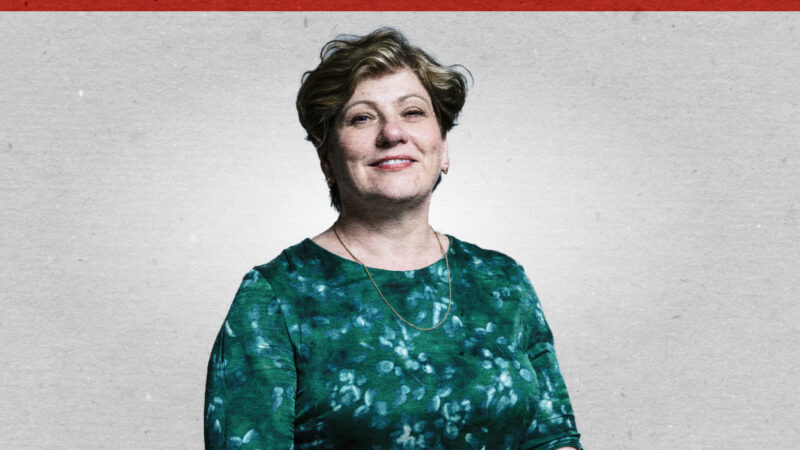
As the women’s suffrage movement grew on both sides of the Atlantic in the 1900s, a popular expression took root to describe those of the other sex apparently bewildered by this turn of events. The deprecatingly-described “mere man” – happy with his lot, his family and his quiet life – could apparently not understand this obsession with rights, equality and empowerment, and wondered where it would end.
110 years ago, Kansas newspaper The Meade County News warned him: “Mere Man faces danger of a Woman President.” In 1916, The Washington Times described the “terrible picture” of a “disgusting loud-voiced woman, in trousers, her hair cut short, sitting in the White House”. The New York Times warned: “All our big battleships will be turned into floating department stores.”
Reading these stereotypical predictions now with a mix of outrage and amusement, it’s hard not to feel a pang of disappointment that what commentators once regarded as inevitable female advancement can sometimes feel as if it is in reverse. For those of a pessimistic outlook, the last few years have certainly felt that way, with Hilary Clinton’s defeat, Angela Merkel’s impending retirement, Aung San Suu Kyi’s shame, and the embarrassment of Theresa May’s premiership.
Where there was once a sense of inexorable history that the US would finally elect its first female President, and the Labour Party its first female leader this year, neither notion secured lasting momentum once the respective contests began. Meanwhile, in Latin America, we have recently gone from four female heads of state to none, losing talent such as Dilma Rousseff and Michelle Bachelet in the process.
And 14 years after the election of Ellen Johnson Sirleaf in Liberia, we are back down to one female African leader, albeit one – in Ethiopian President Sahle-Work Zewde – who is taking great strides alongside PM Abiy Ahmed.
Zewde’s success is one of the clear current reasons to be cheerful, along with Jacinda Ardern’s confident and progressive start to her premiership in New Zealand, Sanna Marin’s leadership of a five-party coalition in Finland, all of them led by women, and Penny Wong’s tireless work to lift a demoralised Labor opposition in Australia.
Together with the hugely-extensive numbers and inspirational nature of women coming through at every level of American politics to challenge Donald Trump, and the fact that women now form a clear majority of the UK Parliamentary Labour Party and represent every ethnicity, religion and background in the process, these are all greatly positive signs for the future.
I sympathise with those women who are tired of seeing future signs, instead of concrete progress now. I share their frustration at seeing another International Women’s Day go by without enough clear political ‘wins’ to offset ‘defeats’ ranging from the Democratic nomination to the appointment of Brett Kavanaugh.
However, as one of life’s optimists, I have seen a breakthrough in recent years in the nature of female leadership, which, for me, bodes very well for the future. One of my great bugbears in the treatment of female politicians is the way that we divide them into particular stereotypes, or worse when female politicians pigeon-hole themselves into those roles to convey a certain impression of who they are.
We have the ‘outspoken’, ‘opinionated’, ‘feisty’ types – more offensively known as ‘battle-axes’ – descriptions commonly attached to the likes of Barbara Castle, Gwyneth Dunwoody, Mo Mowlam, or Clare Short, but never to male counterparts such as Nye Bevan, David Blunkett or John Reid.
We have the ‘ambitious’, ‘opportunistic’, ‘pushy’ types – labels fixed to rising stars of the US political scene like Alexandria Ocasio-Cortez, Kamala Harris and Kirsten Gillibrand, but obviously not to Beto O’Rourke, Cory Booker or Pete Buttigeig.
Conversely, we see male politicians on both sides of the Atlantic widely respected as ‘safe pairs of hands’ – from John Kerry and Tim Kaine to Philip Hammond and Jeremy Hunt – while their female counterparts are dismissed as ‘mousy types’, ‘speak-your-weight machines’ or ‘Stepford Wives’.
Finally, and most perniciously, we see female leaders modelled on Elizabeth the First, and encapsulated in Margaret Thatcher, the ‘exceptional women’ whose physical form belies a male strength and temperament, a comparison Theresa May deliberately reached for with her stomach-churning “Remind him of anybody?” jibe at Jeremy Corbyn at their first Prime Minister’s Questions.
These female leader stereotypes have become so ingrained in our political culture that we barely know what to do with someone who does not fit one. But where does Jacinda Ardern fit? What of Sahle-Work Zewde? And what indeed of Elizabeth Warren, whose withdrawal from the Democratic Primary this week means that ‘Mere Man’ from Meade County can rest easy for another four years?
Erudite but passionate; thoughtful but inspirational; experienced but full of fresh ideas; Warren is not a certain type of female politician. She is just a certain type of politician – and one unlucky to stand in a cycle when Democratic voters are playing safe.
But what she and many others are showing is that they need not be judged by, or conform to, today’s stereotypes any more than the misogynistic predictions we saw in US newspapers a century ago. And it is breaking those stereotypes that is central to breaking the political glass ceiling.
That is why – despite everything – this past year has left me feeling optimistic. It offers hope of a time when people look at the catchphrase associated with Warren, courtesy of Mitch McConnell, “Nevertheless, she persisted”, and do not think ‘she persisted’ because she is a stereotypical woman, but persisted because she is a strong leader. That is our path to true empowerment across the globe.




More from LabourList
‘Violence against women and girls can be prevented. The UK can help lead the way’
‘The government’s workers’ rights agenda must include self-employed people too’
Stella Tsantekidou column: ‘Labour can’t rebuild trust without honesty on migration’